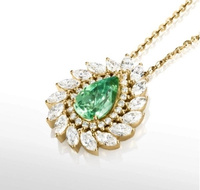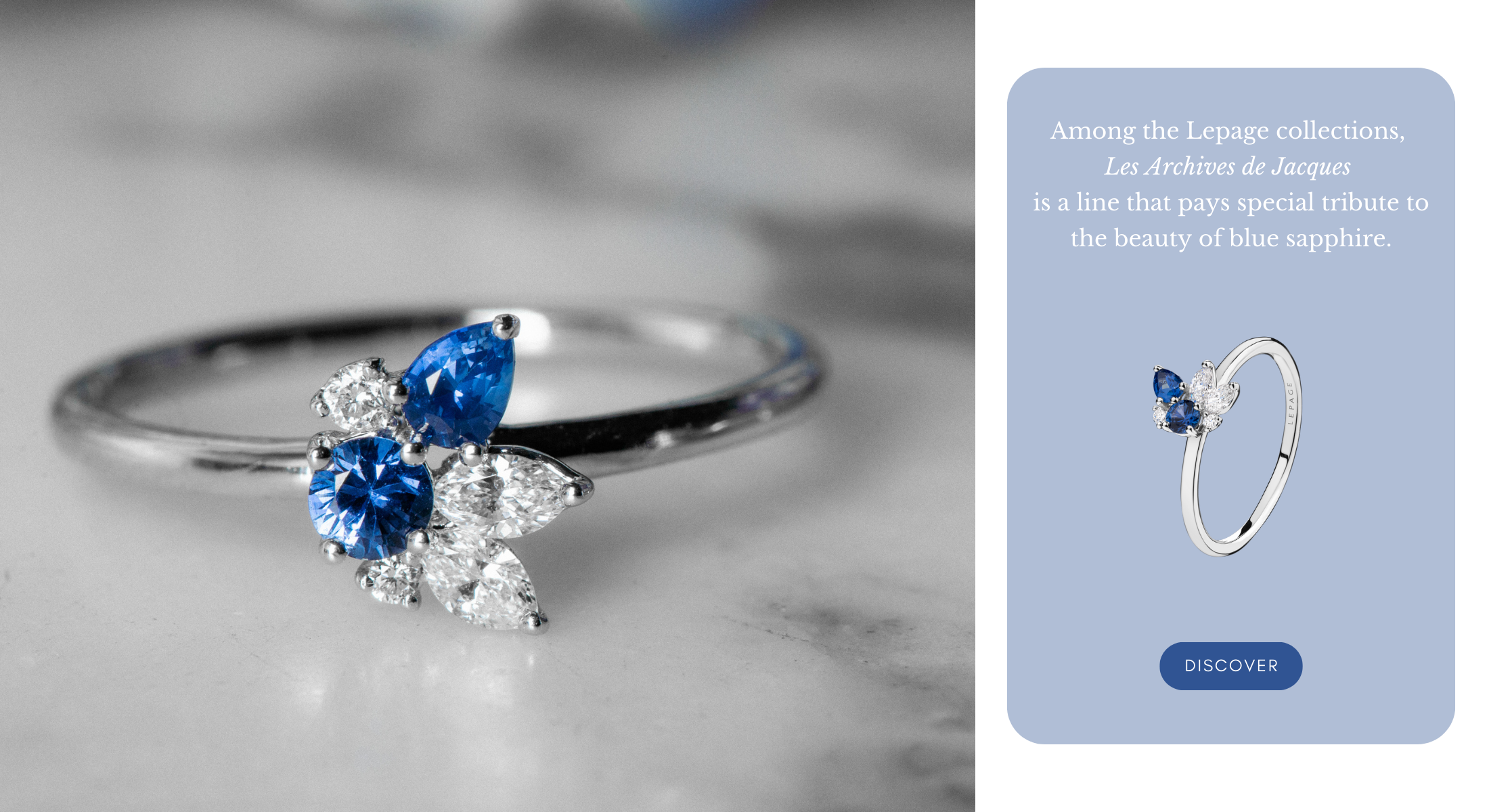Sapphire legends
Like other precious stones, gemstones and natural wonders, sapphire has fascinated mankind for thousands of years. Later in this article, we'll see that sapphire can take on a wide range of colors, but since it's most often represented in its blue version, we'll focus on the latter to evoke the myths and legends that surround this specific gem. For a time, blue sapphire was confused with lapis lazuli, also a blue but opaque ornamental stone, which tends to contain small, natural golden flakes.
Blue sapphire in the Occident
Through the ages and across cultures, sapphire has taken on meanings as varied as they are profound, elevating this blue gem to the rank of sacred symbol and object of covetousness. From ancient Persia to mythological Greece, via biblical texts, sapphire has woven its way into the collective imagination, lending its brilliance a mystical and powerful aura.
For the ancient Persians, sapphire was more than just a stone; it was considered the very foundation of the Earth and the celestial essence that tinted the sky an ethereal blue. This belief gave sapphire a spiritual significance, linking it closely to the creation of the universe and conferring upon it an almost divine status.
One Greek myth had it that Prometheus, the titanic benefactor of mankind, stole sapphire directly from the gods, along with fire. This association underlined the immeasurable value of the gem, which seemed to embody power and freedom.
Sapphire also had a special status in biblical writings. It was mentioned among the sumptuous gems adorning God's throne, a spiritual connotation that reinforced the perception of sapphire as a symbol of purity, wisdom and connection with the divine. Because of its sacred role and reputation associated with religion, sapphire became a stone of great importance to royalty and the aristocracy. Sovereigns, nobles and aristocrats appropriated this precious gem to express their authority and their link with the celestial spheres. Beyond its symbolic power, sapphire was also a symbol of wealth and material prosperity. In those days, the color blue was rare and difficult for painters to obtain, making it a particularly prized hue. As a result, nobles wore sapphire with pride, displaying their opulence and social distinction.
Thus, over the centuries, sapphire acquired a reputation that extended far beyond its physical splendor. A bearer of beliefs, myths and meaning, it continues to inspire mankind, spanning the ages as a guardian of spiritual heritage and a timeless symbol of power and prosperity.
Blue sapphire in the Orient
There are also traces of sapphire legends in Asia, notably the story of Jampala, a skilled and intrepid hunter whose life was marked by a celestial encounter. Jampala lived in a peaceful village surrounded by mountains and lush forests. Every day, he set out on the hunt with his faithful companion, a boomerang carved from a rare and powerful wood, which responded to his commands with unrivalled precision. One moonlit night, when the stars were shining brightly in the dark sky, Jampala looked up and was immediately entranced by a particularly bright and twinkling star. It stood there, engagement ring among the other constellations, exuding a celestial aura that seemed to pierce him to the very depths of his being. Every night, he would stand in the same spot, gazing in admiration at this unique star that seemed to smile at him. But one night, fate played a cruel trick on Jampala. As he made his way to his usual hiding place to contemplate his beloved star, a wild beast emerged from the dark shadows of the forest. The menacing creature swooped down on him with unheard-of fury. Panic-stricken, Jampala grabbed his boomerang with a trembling hand and instinctively threw it at the beast, striking it. The boomerang, carried along by the powerful momentum, continued its course into the celestial immensity, and collided with the star he admired so much, causing an explosion of sparkling light. A bright blue flash detached itself from the glittering star and began its fall to earth. Stunned, Jampala watched the small celestial fragment descend gently until it landed at his feet. This piece of star, of immeasurable beauty, radiated an intense blue as if it imprisoned the magic of the sky itself. This was the moment when the star sapphire was born, a precious stone of extraordinary rarity and bewitching beauty. News of Jampala's discovery spread rapidly, attracting treasure seekers, merchants and sages from all corners of Asia. The star sapphire soon became a living legend, a symbol of good luck, protection and eternal love.
Characteristics of sapphire
Composition and attributes
Sapphire is a gem prized in jewelry for its beauty and rarity. One of the four gemstones along with diamond, ruby and emerald, it belongs to the corundum family, a mineral species composed mainly of aluminum oxide (Al2O3). Sapphire's bewitching blue color is attributed to the presence of natural iron and titanium impurities in its crystalline structure. This gemstone forms naturally in metamorphic rocks (a type of rock formed by the transformation of other pre-existing rock types, called parent rocks, under the effect of high pressure, high temperature or a combination of both. They are common within the Earth's crust and are the result of plate tectonics, crustal movements and continental plate collisions), where they undergo high-pressure, high-temperature conditions, giving rise to corundum crystals impregnated with coloring elements.
The colors of sapphire
Although blue is the most emblematic color for sapphire, this precious gem can actually come in a variety of colors, from light to dark blue, as well as shades of green, yellow, pink, violet and orange. Each sapphire color is determined by the presence of specific elements in its crystalline structure.
Among the range of hues that exist, one in particular stands out: the color of padparadscha sapphires. The color of these stones is a subtle blend of pink and orange, with a hint of coral. These sapphires are extremely rare and come mainly from Sri Lanka, although sources can also be found in other parts of the world, notably Tanzania and Madagascar. Because of their rarity and beauty, padparadscha sapphires are highly coveted and are often considered highly valuable collector's gems. The name "padparadscha" derives from Sinhalese, a language spoken in Sri Lanka, meaning "lotus flower". These sapphires are so named for their unique and exceptional color, reminiscent of the delicate hue of lotus flower petals.
Lepage pays tribute to colored sapphires with capsule collection Les Estivales, to discover without delay !
The hardness of sapphire
Sapphire is one of the hardest stones on the Mohs scale, with a hardness of 9, placing it just behind diamond. This high scratch resistance makes it a durable gem for use in jewelry. Sapphires come in a variety of colors, although blue remains the most famous. Transparent or with visible inclusions, sapphire clarity also varies according to how it was formed. The sapphire thus embodies enchanting beauty and profound symbolic meaning, having long been revered as a symbol of royalty, wisdom and fidelity, continuing to fascinate gem enthusiasts the world over.
The symbolism of sapphire
The stone of September natives, and associated with 45 years of marriage, sapphire is also associated with the goddess Artemis, the goddess of hunting, wilderness and the Lune. In some versions of the legends, it is said that sapphire was considered the sacred stone of Artemis, protecting those devoted to her. Mythological beliefs and attributions may vary according to culture and time, but in ancient times, sapphire was often linked to divinities associated with the Lune, femininity and nature.
Sapphire in lithotherapy
Lithotherapy, affiliated with non-conventional alternative medicine, is based on the properties, influence and power of minerals on the body's mental and physical well-being (the term "lithos" designating stone and "therapy" evoking care and healing). Nevertheless, it's crucial to note that this approach has not been validated by official medicine, and no scientific evidence has ever supported its efficacy. In the event of pain or health problems, it is imperative to consult a licensed professional.
Beliefs in lithotherapy are based on the notion of vibrations and the circulation of energies, which interact with our chakras (small points of convergence of energy within our body), our organs and our emotions. In this respect, each natural stone is reputed to possess specific faculties and properties.
Sapphire is generally associated with the third eye chakra, also known as ajna in Sanskrit. This chakra is located between the eyebrows and is considered the center of intuition, wisdom and spiritual perception.
The gem's virtues include the development of intuition and the ability to better understand situations, emotions and surrounding energies. In addition, sapphire is said to improve mental clarity, calming the mind and eliminating confused thoughts, thus promoting more enlightened decisions.
Carrying this stone on one's person could therefore provide access to inner wisdom and intuitive knowledge, leading to a better understanding of oneself and others. Sapphire also facilitates communication with the spiritual world, enabling the reception of messages and insights from higher sources.
The power of blue
The color blue is often associated with symbols such as serenity, confidence, stability, loyalty and peace. It also evokes the sky, the ocean and the depth of infinite space. In many cultures, blue is considered a calming, soothing color, evoking feelings of tranquility and harmony. Blue sapphire benefits from these symbols associated with its hue because of its deep, haunting color. The ethereal beauty of blue sapphire recalls the color of the night sky, bringing a sense of calm and reassurance. Its hue also evokes the idea of fidelity and loyalty, making it a popular stone for engagement jewelry.
Sapphire jewelry
Sapphire rings
Giving the gift of a sapphire ring is a wonderful idea in so many ways. First of all, the timeless beauty of sapphire, with its deep, brilliant blue color, makes it a magnificent and captivating gemstone that is sure to charm its recipient. What's more, sapphire is traditionally associated with fidelity and loyalty, making it a powerful symbol of commitment and enduring love. Its rarity and preciousness also add to its appeal, showing the attention and importance accorded to the person to whom the ring is given.
Sapphire necklaces
Worn close to the heart, a sapphire necklace becomes a talisman, a guardian of the deepest emotions. It can be given to celebrate a wedding anniversary, to express a lasting commitment or simply as a symbol of love and deep affection for the person for whom it is intended. With its bewitching blue color, the sapphire necklace is, in addition to its symbolism, an admirable aesthetic choice. A sapphire necklace is an instant eye-catcher, adding a touch of sophistication and luxury to any outfit!
Sapphire Earrings
In the world of jewelry, earrings adorned with sapphires offer undeniable charm and elegance. These precious, bewitchingly blue gems add a touch of refinement and beauty to your everyday life. Whether worn every day or for special occasions, sapphire earrings adapt to any style with ease.
Sapphire bracelets
Wearing a sapphire bracelet enhances the natural beauty of the wrist, adding a touch of color and brilliance to any look. This versatile jewelry can be worn daily to enhance a casual look, or flaunted on special occasions to add a touch of sophistication to your style...
Find all the sapphire jewelry offered for sale in Lepage boutiques on lepage.fr. Our boutiques are located in Lille, Rouen and Le Havre, and you can find opening hours on our website. website, or contact us directly by phone at 03 20 12 04 04.
To follow all the jewelry news of our Maison, subscribe to our Instagram account !






.jpg)
.png)




